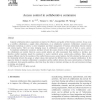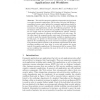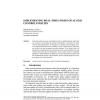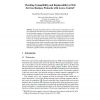JHSN
2006
14 years 3 months ago
2006
We present a refined model for Role Based Access Control policies and define a risk measure for the model, which expresses elements of the operational, combinatorial and conflict ...
DSS
2007
14 years 3 months ago
2007
Corporate collaboration allows organizations to improve the efficiency and quality of their business activities. It may occur as a workflow collaboration, a supply chain collabora...
JCS
2008
14 years 3 months ago
2008
We present a framework for evaluating and generating access control policies. The framework contains a modelling formalism called RW, which is supported by a model checking tool. ...
IADIS
2004
14 years 4 months ago
2004
The PolicyUpdater1 system is a generic access control system that provides policy evaluations and dynamic policy updates. These functions are achieved by the use of a logic-based ...
DBSEC
2006
14 years 4 months ago
2006
The need for enterprise application integration projects leads to complex composite applications. For the sake of security and efficiency, consolidated access control policies for ...
DBSEC
2004
14 years 4 months ago
2004
Real-time update of access control policies, that is, updating policies while they are in effect and enforcing the changes immediately, is necessary for many security-critical appl...
DBSEC
2007
14 years 4 months ago
2007
Abstract. Despite the widespread adoption of Role-based Access Control (RBAC) models, new access control models are required for new applications for which RBAC may not be especial...
ICWS
2010
IEEE
14 years 4 months ago
2010
IEEE
Recently, describing behavior of web services is becoming more and more important. This behavior can be described by business protocols representing the possible sequences of messa...
ACSAC
2008
IEEE
14 years 5 months ago
2008
IEEE
Access control policies are often specified in declarative languages. In this paper, we propose a novel approach, called mutation verification, to assess the quality of properties...
FOSAD
2000
Springer
14 years 6 months ago
2000
Springer
Access control is the process of mediating every request to resources and data maintained by a system and determining whether the request should be granted or denied. The access co...




